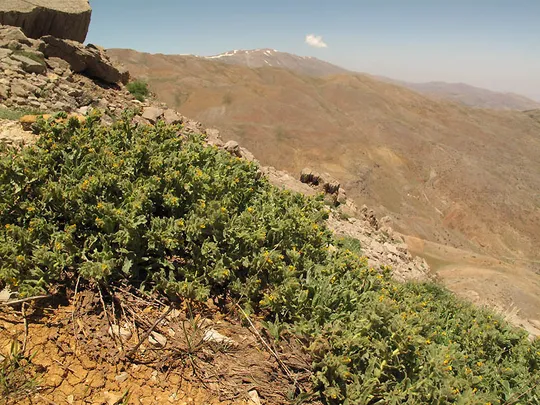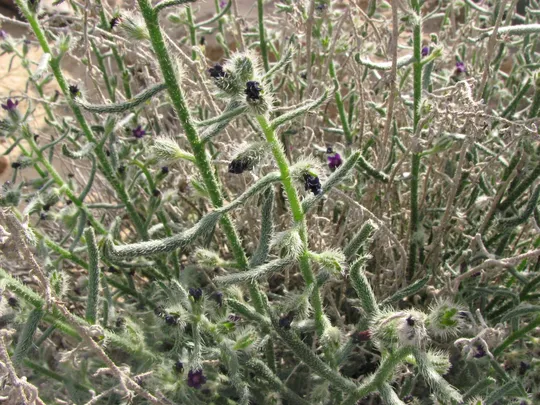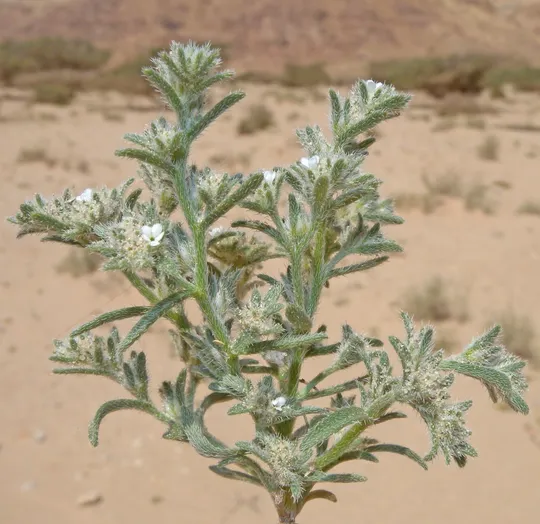Galilean Alkanet
Alkanna galilaea
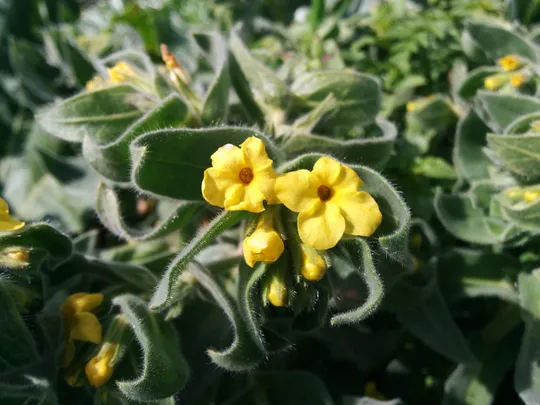
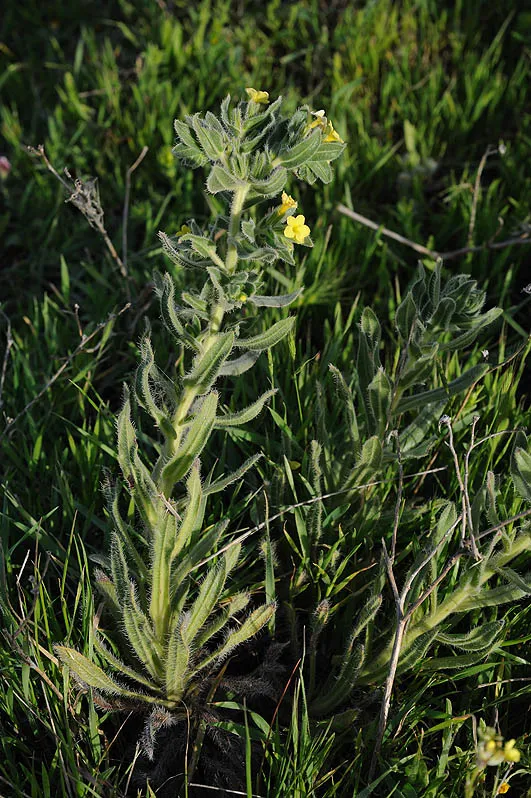

Alkanna galilaea is a perennial herb 30-50 cm high. The entire plant is covered in soft, long hairs that give it a velvety texture. The stem splits near the ground into branches that are long and flowering, prostrate or upright. The leaves are alternate, symmetrically overlapping, oval and stalkless. Basal leaves are elongated-lanced, narrowing towards their base. Flower bracts are oval, heart-shaped at their bases and longer than the fruit calyxes, they are similar to the true leaves below, but smaller. The inflorescences are one-sided and not dense. Calyx lobes are lanced, triangular to elongated, reaching a length of 15 mm on the fruit. Yellow flowers are located in terminal leaf axils. A. galilaea has a rotate corolla, with a narrow, 11-14 mm tube and a round flat limb, 10-12 mm across. The corolla is hairy on the outside and lacks scales at its opening. Flowering begins in March, peaks in mid-April to May and continues until July. Pollination is by long-tongued bees that visit the flowers and suck their abundant nectar. Only long-proboscid bees (or Bombylidae flies), that have a proboscis longer than 9 mm (the length of the A. galilaea tube), can reach the nectar located at the base of the corolla tube. The fruit is composed of four almost spherical mericarps unlike the elongated mericarps in A. orientalis, a close species. The mericarp has a rough coat and is 4.5 mm wide.
A red dye similar to
henna (which is produced from Lawsonia) is produced from the roots of Alkanna
galilaea. This is the source of the genus name in Hebrew, Alkanna,
derived from the Arabic word “al-henna.” Bedouin women decorate their faces and
hands with the A. galilaea pigment.
Alkanna galilaea is found in a relatively large number
of locations in three regions: the Gilboa (near Malkishua), lower Galilee (Adami
Ridge) and the Jezreel Valley. In addition, it was found a single time at Gitit
in the Samaria ecotone. The species was collected for the herbarium from the
lower Jordan Valley (Saint John Monastery, 1942) and the Acre Valley (1929),
but has not been found there since. In Flora Palaestina, it was recorded from
the upper Jordan Valley.
Deep valley soil in the
mountains, on highlands and in large valleys, which is not used for intensive
agriculture, and in heavy, occasionally rocky soils in fallow and agricultural
fields.
The genus Alkanna
has about 30 species, most of which are common around the Mediterranean Sea
Basin. Alkanna galilaea is systematically closer to Alkanna
orientalis, which grows in the tragacanth belt on the mountains of the Middle
East and the Levant, and can be found on the Edom Mountains, southern Sinai and
the Lebanon and Hermon mountains. A. orientalis grows on the peaks of
the Hermon, Edom Mountains and the mountains of southern Sinai, while A.
galilaea grows at the edges of alluvial soil in the lower Galilee and on the
Gilboa. It is endemic to Israel, and apparently evolved from A. orientalis
just “recently”, during the Holocene: as the climate dried up in the Holocene,
the tragacanth flora retreated to the mountain tops; some of its species became
extinct, some survived only on mountain tops and some underwent speciation and
adapted themselves to the arid Mediterranean climate.
·
Alkanna galilaea grows in deep soil, which is not utilized for modern
agriculture. This type of habitat is becoming increasingly rare in the area
occupied by A. galilaea. Its exclusive
affinity for this habitat has made it more sensitive to extinction. The plant
is noticeable, but not sufficiently attractive to be threatened by picking.
Most of the locations in the lower Galilee and the Jezreel Valley are close to settlements,
which increase the threat to the species. The rare species survey conducted in
the 1990s shows that A. galilaea survived
primarily in the eastern portion of the lower Galilee and Jezreel Valley, and
became extinct in the western parts, which are more intensively cultivated.
·
Most
of its locations are located more than 5 km apart, which makes cross-pollination
difficult.
·
Alkanna galilaea is partially protected in the Mount Gilboa Reserve.
The remaining populations are not in the reserve.
Alkanna galilaea populations should be preserved in traditionally
farmed sites, without intensive cultivation, in view of its preferred habitat
at the edges of red alluvial soil. The most urgent recommendation is immediate
collection of live material (seeds and plants) and cultivating them in the
areas allotted for this purpose. In addition, the presence of the species
should be monitored throughout the year in the known locations. It is probably not
possible to protect the species in its remaining locations, as they are all within
or at the edges of agricultural lands.
The plant is considered
endemic only in Israel, but grows in Jordan as well, in the area of Balka west
of Amman, which Flora Palaestina considers the “Ammon” region, thus making it
sub-endemic.
Alkanna galilaea is a small endemic shrub, limited to only
three regions in Israel. Small populations have survived in a few locations, particularly
in the eastern part of the lower Galilee and Jezreel Valley; it is extinct in
the western portions that are more intensively cultivated. It is endangered,
because its only habitat is deep soil that is suited for cultivation. A. galilaea
is disappearing from Israel and the world before our eyes.
Current Occupancy Map
| 1000 squre meter pixel | 5000 squre meter pixel | 10000 squre meter pixel | |
|---|---|---|---|
| number of observations | 0 | 0 | 0 |
| in total pixels | 0 | 0 | 0 |
| Family | Boraginaceae |
| Classification | On the endangered species list |
| Ecosystem | Mediterranean and Semi-Steppe Belt |
| Chorotype | Mediterranean |
| Conservation Site | Gilboa Nature Reserve (Malkishua) and Adami Ridge Reservation (near Yavne’el) |
| Rarity |
1
3
6
|
|---|---|
| Vulnerability |
0
3
4
|
| Attractiveness |
0
0
4
|
| Endemism |
0
3
4
|
| Red number |
1
4.7
10
|
| Peripherality | 0 |
| IUCN category | DD EW EX LC CR EN VU NT |
| Threat Definition according to the red book | Endangered |
 Based on:
Based on:
